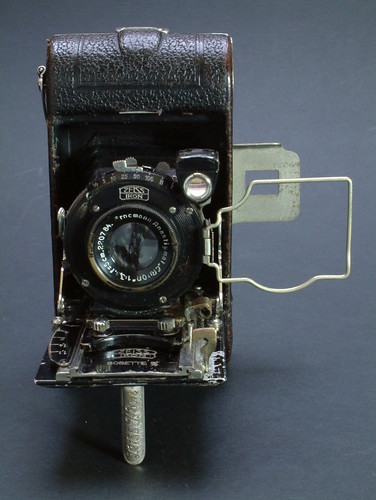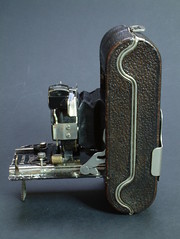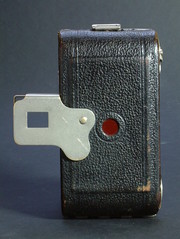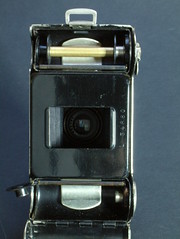Difference between revisions of "Bobette II"
m (→Specifications: Noted that Cronos name not engraved on the shutter) |
m (Noted that the unperforated 35 mmfilm in the Bobette isn't 828 or Bolta.) |
||
| Line 1: | Line 1: | ||
The Bobette II is one of the [[Ernemann]] cameras that was continued in production after the merger that created [[Zeiss Ikon]] in 1926.<ref name=McK>{{McKeown12}} Page 269 for the listing as an Ernemann product, and 1038 as a Zeiss Ikon one.</ref> It is Zeiss Ikon's model 548. | The Bobette II is one of the [[Ernemann]] cameras that was continued in production after the merger that created [[Zeiss Ikon]] in 1926.<ref name=McK>{{McKeown12}} Page 269 for the listing as an Ernemann product, and 1038 as a Zeiss Ikon one.</ref> It is Zeiss Ikon's model 548. | ||
| − | It is a small folding camera, with a metal body covered with leather (not leatherette). The | + | It is a small folding camera, with a metal body covered with leather (not leatherette). The example shown here makes images 22 x 32 mm on roll film, 35 mm wide (i.e. unperforated film with a backing paper), and McKeown gives this size (and states that the film would allow 24 exposures on a roll).<ref name=McK></ref> One owner, however, reports an example with a ''29'' x 32 mm frame.<ref>Reported in a comment on a [http://www.flickr.com/photos/century_graphic/5448072565/ picture of the Bobette II] at Flickr (one of the pictures shown here); the camera is described as having the 4.2 cm f/2 Ernostar lens.</ref> The film for the Bobette cameras may have been unique to them; a standard [[828 film|828]] spool does not fit in the film chamber. In any case, the 828 size did not exist until 1935, and [[Bolta film]] was introduced with the [[Boltavit]] in 1936. |
| + | |||
| + | Whereas the [[Ernemann Bobette I]] (also continued as Zeiss Ikon's model 549) is a strut-folding model, the II is a conventional folder, the front opening to form a bed with focus rails on which the lens standard slides out. Focusing is by means of a radial lever on the right hand side of the focusing rails, with a scale. The camera is not self-erecting. | ||
It has both a [[brilliant finder]] and a wire frame finder. The front, wire part of this is hinged on the lens standard. The rear part is a plate mounted by a swivel pin on the camera back, and also serves to cover the [[red window]] when swivelled down. The camera has a film winding key on the right-hand side, where there is also a ⅜-inch tripod socket.<br> | It has both a [[brilliant finder]] and a wire frame finder. The front, wire part of this is hinged on the lens standard. The rear part is a plate mounted by a swivel pin on the camera back, and also serves to cover the [[red window]] when swivelled down. The camera has a film winding key on the right-hand side, where there is also a ⅜-inch tripod socket.<br> | ||
Revision as of 18:11, 26 July 2012
The Bobette II is one of the Ernemann cameras that was continued in production after the merger that created Zeiss Ikon in 1926.[1] It is Zeiss Ikon's model 548.
It is a small folding camera, with a metal body covered with leather (not leatherette). The example shown here makes images 22 x 32 mm on roll film, 35 mm wide (i.e. unperforated film with a backing paper), and McKeown gives this size (and states that the film would allow 24 exposures on a roll).[1] One owner, however, reports an example with a 29 x 32 mm frame.[2] The film for the Bobette cameras may have been unique to them; a standard 828 spool does not fit in the film chamber. In any case, the 828 size did not exist until 1935, and Bolta film was introduced with the Boltavit in 1936.
Whereas the Ernemann Bobette I (also continued as Zeiss Ikon's model 549) is a strut-folding model, the II is a conventional folder, the front opening to form a bed with focus rails on which the lens standard slides out. Focusing is by means of a radial lever on the right hand side of the focusing rails, with a scale. The camera is not self-erecting.
It has both a brilliant finder and a wire frame finder. The front, wire part of this is hinged on the lens standard. The rear part is a plate mounted by a swivel pin on the camera back, and also serves to cover the red window when swivelled down. The camera has a film winding key on the right-hand side, where there is also a ⅜-inch tripod socket.
Unfolding the table stand operates the catch to open the front. Once the bed is unfolded, the lens standard can be pulled out of the body, holding the two studs on the standard. The left-hand one of these (as seen from behind the camera) is spring-loaded, to allow a notch on the standard to engage with a pin on the left-hand focus rail. This sets the standard position so that the focus scale is correct. Perhaps because of shrinkage with age, in the example pictured, the tension of the bellows is enough to pull the right hand side of the standard back, so care is needed to keep it parallel to the film.
Closing the camera is the reverse of the above. The table stand must be unfolded, the lens standard disengaged from the pin on the focus rail and pushed into the body, and the focus scale set to infinity before the camera will close.
In the example pictured, two brass loops have been fastened to the left focus rail (the camera's left; on the right of the picture) by a previous owner. Their purpose is not clear. Also, the original aperture scale is missing; the pictures show a paper one.
|
|
| ||||||
|
| |||||||
| Zeiss Ikon Bobette II. Images by Dustin McAmera (Image rights) | ||||||||
Specifications
- Type: Folding roll-film camera
- Format: 22x32mm (on un-perforated roll film, 35 mm wide)[3]
- Manufacturer: Ernemann and later Zeiss Ikon
- Years of production: 1926 by Ernemann; 1926-1929 by Zeiss Ikon[4]
- Lenses:
- Ernemann Ernoplast 5 cm f/4.5 (listed in McKeown only for Ernemann, not Zeiss Ikon)
- Ernemann Ernon anastigmat 5 cm f/3.5
- Ernemann Ernostar 4.2 cm f/2
- Shutter: Cronos everset shutter (though not engraved with the name); 1/5 - 1/100 second, plus 'B' and 'T'. Cable release socket. No delayed action.
- Viewfinder: Folding frame finder and brilliant finder
- Focusing: Sliding rails on bed, with radial lever. Scale in metres, from 1.1 m to infinity.
- Dimensions: 112 x 62 x 36 mm (folded); depth when erected approx. 90 mm
- Weight: 375 g
Notes
- ↑ 1.0 1.1 McKeown, James M. and Joan C. McKeown's Price Guide to Antique and Classic Cameras, 12th Edition, 2005-2006. USA, Centennial Photo Service, 2004. ISBN 0-931838-40-1 (hardcover). ISBN 0-931838-41-X (softcover). Page 269 for the listing as an Ernemann product, and 1038 as a Zeiss Ikon one.
- ↑ Reported in a comment on a picture of the Bobette II at Flickr (one of the pictures shown here); the camera is described as having the 4.2 cm f/2 Ernostar lens.
- ↑ A catalogue page including the Bobette (I and II) at Sylvain Halgand's Collection d'Appareils includes these cameras as using film-ciné; a price is given for a 24-exposure roll of film; no type number is given for this film size; perhaps it is unique to a few Zeiss Ikon models.
- ↑ This date is probably right: McKeown dates the Ernemann camera to 1926 (the year of the merger to form Zeiss Ikon), and the Zeiss Ikon camera to 1929, but it seems unlikely that Zeiss would reintroduce the model after a gap of two years.
Links
- Ernemann Bobette II sold at the November 2002 Westlicht Auction in Vienna.
- Zeiss Ikon Bobette II (with the wire frame finder removed, and an optical finder added) at the May 2011 Westlicht Auction.




